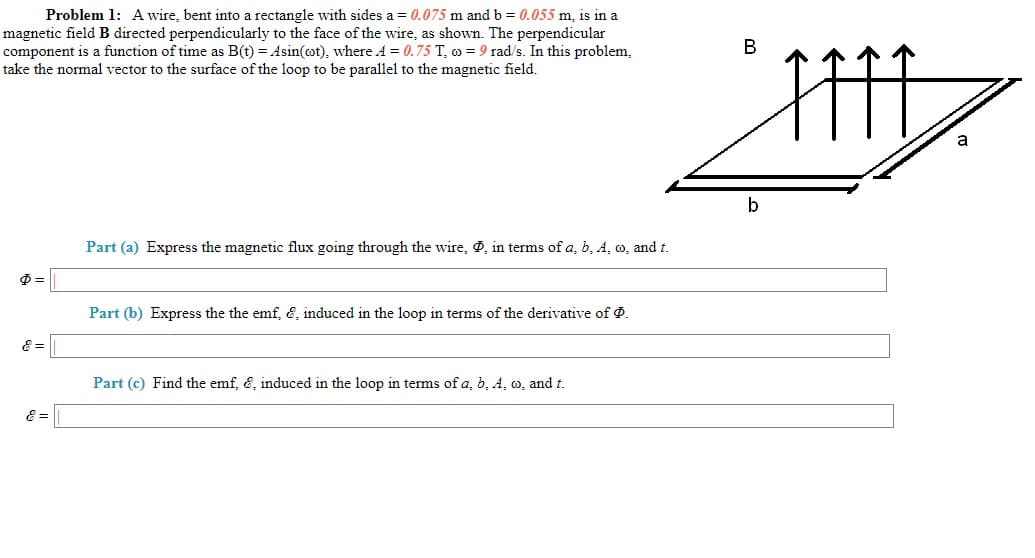Problem 1: A wire, bent into a rectangle with sides a = 0.075 m and b = 0.055 m, is in a magnetic field B directed perpendicularly to the face of the wire, as shown. The perpendicular component is a function of time as B(t) = Asin(ot), where A = 0.75 T, o = 9 rad/s. In this problem, take the normal vector to the surface of the loop to be parallel to the magnetic field. В b Part (a) Express the magnetic flux going through the wire, , in terms of a, b, A, o, and t. Part (b) Express the the emf, &, induced in the loop in terms of the derivative of Ø. Part (c) Find the emf, &, induced in the loop in terms of a, b, A, o, and t.
Problem 1: A wire, bent into a rectangle with sides a = 0.075 m and b = 0.055 m, is in a magnetic field B directed perpendicularly to the face of the wire, as shown. The perpendicular component is a function of time as B(t) = Asin(ot), where A = 0.75 T, o = 9 rad/s. In this problem, take the normal vector to the surface of the loop to be parallel to the magnetic field. В b Part (a) Express the magnetic flux going through the wire, , in terms of a, b, A, o, and t. Part (b) Express the the emf, &, induced in the loop in terms of the derivative of Ø. Part (c) Find the emf, &, induced in the loop in terms of a, b, A, o, and t.
Chapter11: Magnetic Forces And Fields
Section: Chapter Questions
Problem 72AP: A particle moving downward at a speed of 6.0106 m/s enters a uniform magnetic field that is...
Related questions
Question
E14P1

Transcribed Image Text:Problem 1: A wire, bent into a rectangle with sides a = 0.075 m and b = 0.055 m, is in a
magnetic field B directed perpendicularly to the face of the wire, as shown. The perpendicular
component is a function of time as B(t) = Asin(ot), where A = 0.75 T, o = 9 rad/s. In this problem,
take the normal vector to the surface of the loop to be parallel to the magnetic field.
В
a
b
Part (a) Express the magnetic flux going through the wire, , in terms of a, b, A, o, and t.
Part (b) Express the the emf, E, induced in the loop in terms of the derivative of Ø.
Part (c) Find the emf, E, induced in the loop in terms of a, b, A, o, and t.
Expert Solution
This question has been solved!
Explore an expertly crafted, step-by-step solution for a thorough understanding of key concepts.
This is a popular solution!
Trending now
This is a popular solution!
Step by step
Solved in 2 steps with 1 images

Knowledge Booster
Learn more about
Need a deep-dive on the concept behind this application? Look no further. Learn more about this topic, physics and related others by exploring similar questions and additional content below.Recommended textbooks for you


Physics for Scientists and Engineers: Foundations…
Physics
ISBN:
9781133939146
Author:
Katz, Debora M.
Publisher:
Cengage Learning

Principles of Physics: A Calculus-Based Text
Physics
ISBN:
9781133104261
Author:
Raymond A. Serway, John W. Jewett
Publisher:
Cengage Learning


Physics for Scientists and Engineers: Foundations…
Physics
ISBN:
9781133939146
Author:
Katz, Debora M.
Publisher:
Cengage Learning

Principles of Physics: A Calculus-Based Text
Physics
ISBN:
9781133104261
Author:
Raymond A. Serway, John W. Jewett
Publisher:
Cengage Learning